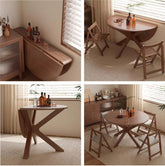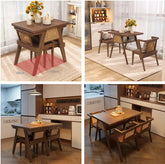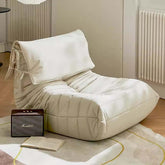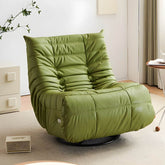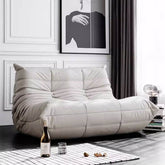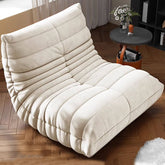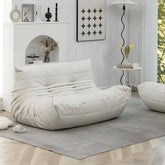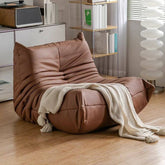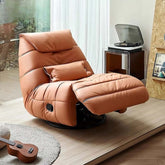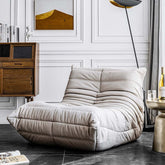Fauteuils Chenille en Cuir : Guide Complet pour 2025
Bienvenue dans l'univers fascinant des fauteuils chenille en cuir ! Ces pièces de mobilier uniques gagnent en popularité dans les cercles de design d'intérieur, alliant un confort inégalé à une esthétique distinctive. Loin d'être une simple option de siège, le fauteuil chenille en cuir offre un mélange de soutien ergonomique et d'attrait visuel qui peut transformer n'importe quel espace de vie. Que vous soyez un passionné de design chevronné ou un novice explorant des solutions de mobilier innovantes, ce guide vise à fournir une exploration approfondie de tout ce que vous devez savoir sur ces fauteuils remarquables. De leurs origines et philosophie de design aux différents types de cuir utilisés, leurs nombreux avantages et conseils d'entretien essentiels, nous couvrons tout. Préparez-vous à découvrir comment ces fauteuils peuvent rehausser le confort et le style de votre maison, offrant un refuge confortable aussi saisissant visuellement qu'agréable.
Comprendre les Fauteuils Chenille en Cuir
Le terme "fauteuil chenille" peut évoquer l'image d'une créature segmentée fantaisiste, et d'une certaine manière, c'est exactement ce que ces fauteuils incarnent dans leur design. Contrairement aux fauteuils ou canapés traditionnels, les fauteuils chenille se caractérisent par leur construction segmentée, souvent modulaire, qui permet une grande flexibilité et adaptabilité ergonomique. Cette philosophie de design repose sur l'idée de créer un mobilier qui épouse les courbes naturelles du corps, offrant un confort et un soutien inégalés. Lorsqu'ils sont fabriqués en cuir, ces fauteuils élèvent le concept de confort avec une touche de luxe et de durabilité.
La Philosophie de Design des Fauteuils Chenille
La philosophie centrale des fauteuils chenille repose sur des formes organiques et un confort adaptatif. Inspirés par la nature, en particulier le corps segmenté d'une chenille, ces fauteuils sont conçus pour être très flexibles et réactifs à la posture de l'utilisateur. Cette modularité se traduit souvent par des coussins ou sections individuels qui peuvent être ajustés ou réarrangés, offrant une expérience d'assise personnalisée. L'absence de cadres rigides dans de nombreux designs renforce leur esthétique moelleuse et accueillante, en faisant un point focal dans tout intérieur contemporain.
Évolution du Concept de Fauteuil Chenille
Bien que l'origine exacte du nom spécifique "fauteuil chenille" soit quelque peu floue, les principes de design remontent au modernisme du milieu du 20e siècle, qui mettait l'accent sur des formes organiques, un design ergonomique et un départ des meubles rigides et formels. Les designers cherchaient à créer des pièces non seulement fonctionnelles, mais aussi esthétiquement attrayantes et adaptables à divers espaces de vie. L'utilisation de mousse et de matériaux flexibles est devenue centrale pour obtenir ces formes fluides, permettant la création de sièges qui épousent véritablement le corps. Au fil du temps, ce concept a évolué, intégrant divers matériaux et options de rembourrage, le cuir émergeant comme un choix premium pour sa durabilité, son attrait esthétique et sa qualité tactile.
Pourquoi le Cuir ? L'Avantage du Matériau
Le choix du cuir pour les fauteuils chenille n'est pas seulement esthétique ; il apporte une multitude d'avantages pratiques qui améliorent à la fois la longévité du fauteuil et l'expérience de l'utilisateur. Le cuir est réputé pour sa durabilité, développant une patine unique au fil du temps qui ajoute du caractère et de la profondeur. Il est également étonnamment adaptable, frais en été et chaud en hiver, ce qui en fait un choix confortable tout au long de l'année. De plus, l'élasticité naturelle du cuir lui permet de s'adapter aux contours du corps, complétant le design ergonomique des fauteuils chenille.
Types de Cuir Utilisés dans les Meubles
Comprendre les différents types de cuir est crucial lors du choix d'un fauteuil chenille en cuir. Chaque type offre des caractéristiques distinctes en termes d'apparence, de toucher et de durabilité :
- Cuir pleine fleur : C'est le cuir de la plus haute qualité, conservant le grain naturel et les imperfections de la peau. Il est extrêmement durable et développe une patine riche avec le temps.
- Cuir fleur corrigée : Légèrement plus fin que le cuir pleine fleur, le cuir fleur corrigée a été poncé en surface et un fini appliqué. Il est plus résistant aux taches mais moins respirant que le cuir pleine fleur.
- Cuir refendu (cuir véritable) : Fabriqué à partir des couches inférieures de la peau, le cuir refendu est moins durable et souvent fortement traité. Bien qu'il s'agisse de vrai cuir, il n'offre pas la même longévité ou attrait esthétique que le cuir pleine fleur ou fleur corrigée.
- Cuir reconstitué : C'est la qualité la plus basse, fabriqué à partir de chutes de cuir collées ensemble avec un adhésif. Il manque de durabilité et de sensation du cuir véritable.
- Cuir synthétique/cuir vegan : Ce sont des matériaux synthétiques conçus pour imiter l'apparence et la sensation du vrai cuir. Bien qu'ils offrent une alternative éthique, leurs caractéristiques de durabilité et de vieillissement diffèrent significativement.
Avantages du Rembourrage en Cuir
Outre son attrait esthétique, le rembourrage en cuir offre plusieurs avantages pour les meubles, en particulier pour une pièce comme le fauteuil chenille :
- Durabilité : Le cuir est exceptionnellement résistant et peut supporter des années d'utilisation, ce qui en fait un investissement à long terme.
- Confort : Il s'adapte à la température corporelle, offrant un confort toutes saisons. Son élasticité naturelle lui permet également de se mouler à l'utilisateur, renforçant les avantages ergonomiques du fauteuil.
- Entretien facile : Bien qu'il nécessite un entretien spécifique, le cuir est relativement facile à nettoyer, souvent nécessitant juste un essuyage avec un chiffon humide pour les éclaboussures.
- Hypoallergénique : Contrairement au tissu, le cuir ne retient pas les acariens, les poils d'animaux ou autres allergènes, ce qui en fait un bon choix pour les personnes souffrant d'allergies.
- Vieillissement élégant : Le cuir de haute qualité développe une belle patine avec le temps, renforçant son caractère et son attrait.
Ergonomie et Confort : Le Cœur du Fauteuil Chenille
L'attrait principal du fauteuil chenille, surtout lorsqu'il est rembourré en cuir, réside dans son confort exceptionnel et son design ergonomique. Ces fauteuils sont conçus pour offrir un soutien et une relaxation optimaux, ce qui les rend idéaux pour de longues périodes de détente, de lecture ou simplement de repos. La structure segmentée joue un rôle crucial à cet égard, permettant au fauteuil de s'adapter à diverses formes corporelles et préférences d'assise.
Soutien Adaptatif et Répartition de la Pression
Les segments individuels d'un fauteuil chenille travaillent de concert pour répartir le poids corporel uniformément, réduisant les points de pression qui peuvent causer de l'inconfort dans les sièges traditionnels. Ce soutien adaptatif signifie que, que vous soyez assis droit, incliné ou même allongé, le fauteuil s'adapte à votre posture, offrant un confort continu. Cela est particulièrement bénéfique pour les personnes cherchant un soulagement des douleurs dorsales ou celles qui passent beaucoup de temps assises.
Le Rôle de la Mousse Haute Densité et des Remplissages
La douceur et les qualités de soutien des fauteuils chenille sont largement dues à la mousse haute densité et aux autres remplissages utilisés dans leur construction. Cette mousse fournit une base résiliente mais douce qui empêche l'affaissement et maintient la forme du fauteuil au fil du temps. La qualité de la mousse impacte directement la longévité et le confort du fauteuil, les mousses de plus haute densité offrant un soutien et une durabilité supérieurs. Certains designs peuvent également incorporer du coton de poupée ou d'autres remplissages doux pour renforcer la sensation de nuage, créant un havre invitant pour la détente.

Attrait Esthétique et Intégration Intérieure
Outre leur confort, les fauteuils chenille en cuir sont célébrés pour leur esthétique distinctive, qui peut considérablement améliorer l'attrait visuel de n'importe quel espace intérieur. Leurs formes organiques uniques rompent avec les designs de meubles conventionnels, en faisant une pièce maîtresse qui attire l'œil et suscite la conversation. La combinaison de la forme sculpturale du fauteuil et de la texture luxueuse du cuir crée une ambiance sophistiquée mais accueillante.
Compatibilité avec les Designs Modernes et Contemporains
Les fauteuils chenille en cuir s'intègrent parfaitement dans les schémas de design modernes et contemporains. Leurs lignes épurées, souvent des profils minimalistes, et l'accent mis sur la forme et la fonction s'alignent parfaitement avec ces esthétiques. Ils peuvent servir de point focal audacieux dans un salon, un coin lecture confortable dans une chambre, ou une option d'assise invitante dans un bureau spacieux. La polyvalence du cuir, disponible dans une large gamme de couleurs allant des bruns et noirs classiques aux teintes plus vibrantes, permet une personnalisation supplémentaire pour correspondre au décor existant.
Créer une Pièce Maîtresse
L'un des aspects les plus convaincants d'un fauteuil chenille en cuir est sa capacité à agir comme une pièce maîtresse. Sa forme non conventionnelle et son matériau luxueux garantissent qu'il se démarque, ajoutant du caractère et de la personnalité à une pièce. Contrairement aux meubles produits en masse, ces fauteuils possèdent souvent une qualité artisanale, reflétant un savoir-faire soigné et une vision de design unique. Cela en fait plus que de simples meubles ; ce sont des œuvres d'art qui contribuent à la narration globale d'un espace.
Considérations Pratiques : Entretien et Longévité
Investir dans un fauteuil chenille en cuir signifie acquérir une pièce de mobilier conçue pour la longévité. Cependant, pour garantir que sa beauté et son confort perdurent pendant des années, un entretien et des soins appropriés sont essentiels. Bien que le cuir soit durable, il bénéficie d'un nettoyage et d'un conditionnement réguliers pour éviter le dessèchement, les fissures et la décoloration.
Conseils de Nettoyage et d'Entretien Réguliers
Un entretien régulier est essentiel pour préserver l'état impeccable de votre fauteuil chenille en cuir. Voici quelques conseils essentiels :
- Dépoussiérage : Dépoussiérez votre fauteuil en cuir chaque semaine avec un chiffon doux et sec pour empêcher l'accumulation de saleté et de poussière dans les pores du cuir.
- Essuyage des déversements : Tamponnez immédiatement tout déversement avec un chiffon propre et sec. Évitez de frotter, car cela peut étendre la tache. Pour les déversements tenaces, un chiffon légèrement humide avec du savon doux peut être utilisé, mais testez toujours sur une zone peu visible d'abord.
- Éviter le soleil direct et la chaleur : Une exposition prolongée au soleil direct ou à des sources de chaleur (comme les radiateurs) peut causer la décoloration, le dessèchement et les fissures du cuir. Placez votre fauteuil à l'écart de ces éléments.
- Aspiration : Utilisez un embout brosse douce sur votre aspirateur pour enlever les miettes et les débris des crevasses et des coutures.
Conditionnement pour la Longévité
Tout comme la peau humaine, le cuir doit être hydraté pour rester souple et éviter les fissures. Conditionner votre fauteuil chenille en cuir tous les 6 à 12 mois est fortement recommandé :
- Choisir le bon conditionneur : Utilisez un conditionneur de cuir de haute qualité spécifiquement conçu pour les meubles. Évitez les produits chimiques agressifs ou les nettoyants ménagers.
- Appliquer uniformément : Appliquez une petite quantité de conditionneur sur un chiffon doux et propre et frottez doucement le cuir en mouvements circulaires.
- Polir : Après avoir laissé le conditionneur pénétrer pendant quelques minutes (selon les instructions du produit), polissez la surface avec un chiffon propre et sec pour enlever tout excès et restaurer un éclat naturel.

Choisir Votre Fauteuil Chenille en Cuir
Avec une variété croissante de fauteuils chenille en cuir disponibles, sélectionner celui qui convient parfaitement à votre maison implique de prendre en compte plusieurs facteurs, du type de cuir à la taille du fauteuil, sa modularité et son design global. Prendre une décision éclairée garantit que vous investissez dans une pièce qui répond non seulement à vos préférences esthétiques, mais qui offre également un confort et une fonctionnalité durables.
Facteurs à Considérer Avant l'Achat
- Type de cuir : Comme discuté, les cuirs pleine fleur et fleur corrigée offrent une durabilité et un attrait esthétique supérieurs. Considérez votre budget et l'usure que le fauteuil subira.
- Taille et espace : Les fauteuils chenille peuvent aller de loungers à une place à des canapés multi-segments. Mesurez soigneusement votre espace pour vous assurer que le fauteuil s'intègre confortablement sans dominer la pièce.
- Modularité : Certains fauteuils chenille offrent des composants modulaires qui peuvent être réarrangés. Décidez si cette flexibilité est importante pour votre style de vie et votre espace.
- Couleur et finition : Le cuir est disponible dans une vaste gamme de couleurs et de finitions. Choisissez une teinte qui complète votre décor existant et reflète votre style personnel.
- Cadre et remplissage : Bien que de nombreux fauteuils chenille soient entièrement en mousse, certains peuvent avoir des cadres internes. Renseignez-vous sur la qualité de la mousse et des structures internes pour assurer la durabilité.
Points Clés
- Les fauteuils chenille en cuir combinent un design segmenté unique avec un cuir luxueux pour un confort et un style supérieurs.
- Ils offrent des avantages ergonomiques grâce à un soutien adaptatif et une répartition uniforme de la pression.
- Différents types de cuir impactent la durabilité et l'esthétique ; le cuir pleine fleur et fleur corrigée sont des choix premium.
- Un entretien approprié, incluant un nettoyage et un conditionnement réguliers, est crucial pour la longévité.
- Ces fauteuils servent de pièces maîtresses distinctives, rehaussant les intérieurs modernes et contemporains.
Questions Fréquemment Posées (FAQ)
Q : Qu'est-ce qui différencie un fauteuil chenille en cuir d'un canapé classique ?
R : Les fauteuils chenille en cuir se distinguent par leur design segmenté, souvent modulaire, qui permet une plus grande adaptabilité ergonomique et une esthétique organique unique. Contrairement aux canapés traditionnels avec des cadres rigides, de nombreux fauteuils chenille présentent un corps entièrement en mousse qui épouse plus étroitement la forme de l'utilisateur, offrant un confort et une répartition de la pression supérieurs.
Q : Comment nettoyer un fauteuil chenille en cuir ?
R : Pour un nettoyage de routine, dépoussiérez votre fauteuil chaque semaine avec un chiffon doux et sec. Tamponnez immédiatement les déversements avec un chiffon propre et sec. Pour un nettoyage plus profond, utilisez un chiffon légèrement humide avec du savon doux, en testant d'abord sur une zone peu visible. Évitez les produits chimiques agressifs et le soleil direct.
Q : Les fauteuils chenille en cuir peuvent-ils convenir aux petits espaces ?
R : Bien que certains fauteuils chenille soient de grande taille, de nombreux designs, en particulier les loungers à une place ou les unités modulaires, sont peu encombrants. Leur profil bas et leur nature adaptable les rendent adaptés aux petites pièces, chambres ou configurations de studio, s'intégrant facilement sans dominer l'espace.
Q : Quel est le meilleur type de cuir pour la durabilité ?
R : Le cuir pleine fleur est considéré comme le type le plus durable, car il conserve toute la couche de grain de la peau, y compris ses imperfections naturelles et sa robustesse. Le cuir fleur corrigée est également très durable, bien qu'il ait été légèrement poncé et fini, le rendant légèrement moins robuste que le cuir pleine fleur mais plus résistant aux taches.
Q : Les fauteuils chenille en cuir nécessitent-ils un assemblage spécial ?
R : De nombreux fauteuils chenille en cuir, en particulier ceux avec une construction entièrement en mousse, nécessitent un assemblage minimal ou nul. Ils arrivent souvent prêts à l'emploi, nécessitant simplement d'être déballés et placés à l'endroit souhaité. Les versions modulaires peuvent nécessiter un simple arrangement des segments.
Conclusion
Le fauteuil chenille en cuir témoigne d'un design de mobilier innovant, combinant harmonieusement une excellence ergonomique avec une esthétique captivante. Comme nous l'avons exploré, ces fauteuils offrent plus qu'un simple endroit pour s'asseoir ; ils offrent un sanctuaire de confort, s'adaptant aux contours de votre corps et offrant une déclaration visuelle unique qui élève n'importe quel intérieur. De la sensation luxueuse et de la durabilité durable du cuir de haute qualité au soutien adaptatif de leur construction segmentée, chaque aspect de ces fauteuils est conçu avec l'utilisateur à l'esprit. Ils représentent un choix conscient pour ceux qui valorisent à la fois la forme et la fonction, cherchant des meubles aussi agréables à l'œil qu'au corps. Investir dans un fauteuil chenille en cuir ne se limite pas à acquérir une pièce de mobilier ; c'est embrasser un mode de vie de confort, de sophistication et de design réfléchi. En comprenant les nuances des types de cuir, les principes du soutien ergonomique et l'importance d'un entretien approprié, vous pouvez vous assurer que votre fauteuil chenille en cuir reste une pièce maîtresse précieuse dans votre maison pendant des années, continuant d'offrir un refuge confortable et une touche d'élégance moderne. Adoptez le charme unique et le confort inégalé que seul un fauteuil chenille en cuir peut offrir, et transformez votre espace de vie en un havre de détente et de style.

Références
- grandgoldman.com - Choisir le Fauteuil Chenille Parfait (Conseils d'Experts) 2025 : Offre des informations sur la sélection des fauteuils chenille, y compris les aspects de design et de confort.
- huset.com.au - Différents Types de Cuir Utilisés dans les Meubles : Un Aperçu Luxueux : Détaille les différents types de cuir utilisés dans les meubles et leurs caractéristiques.
- homedepot.com - Types de Cuir pour les Meubles : Discute des différents types de cuir et de leur adéquation pour les meubles.
- architecturaldigest.com - Comment Nettoyer les Meubles en Cuir pour qu'ils Paraissent Neufs : Fournit des conseils pratiques sur le nettoyage et l'entretien des meubles en cuir.
- furnitureclinic.com - Kit de Soin du Cuir : Offre des conseils sur les produits de soin du cuir et leur application.
- bellonausa.com - Canapés en Cuir : Guide de Soin et d'Entretien : Guide complet sur l'entretien des canapés en cuir, applicable aux fauteuils.
- 25home.com - Décorez Votre Coin avec le Canapé Chenille Paresseux : Discute des avantages esthétiques et ergonomiques des canapés/fauteuils chenille.
